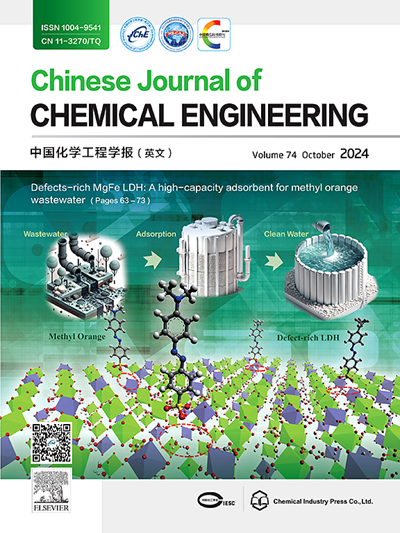利用自掺杂调制高效碳基钙钛矿太阳能电池中的二氧化钛电子传输层
IF 3.7
3区 工程技术
Q2 ENGINEERING, CHEMICAL
引用次数: 0
摘要
在钙钛矿太阳能电池(PSCs)中,构建具有理想表面形貌和有利电子传输动力学的电子传输层(ETL)是非常重要的。在这项工作中,基于一种新的Ti3+自掺杂策略,设计和构建了功能TiO2 ETL。实验结果表明,Ti3+掺杂可以促进前驱体颗粒的组装,减少成孔试剂的含量,增强前驱体在成膜过程中与玻璃基板的附着力,从而优化TiO2薄膜的结晶过程。因此,修饰后的表面形貌抑制了不希望的孔结构的形成。此外,自掺杂适度地在TiO2表面产生氧空位,使TiO2的费米能级变浅。这不仅导致了更强的界面电子耦合,而且还建立了有利的能带对准。这些优点通过抑制复合损失和促进电子提取来优化界面电子传递动力学。得益于优化后的TiO2 ETL,无空穴传输层(HTL)碳电极CsPbI3 PSCs的效率高达18.62%,是该领域的最高水平之一。本文章由计算机程序翻译,如有差异,请以英文原文为准。

Modulating titanium dioxide electron transport layer by self-doping for high-efficiency carbon-based perovskite solar cells
In perovskite solar cells (PSCs), it is important to construct electron transport layer (ETL) with ideal surface morphology and advantageous electron transport dynamics. In this work, a functional TiO2 ETL is designed and constructed based on a novel Ti3+ self-doping strategy. Experimental results indicate that Ti3+ dopant can optimize TiO2 film crystallization process by facilitating the assembly of precursor particles, reducing the content of pore-forming reagent, and enhancing the adhesion of precursors to glass substrate in film formation process. Therefore, the modified surface morphology inhibits the formation of undesired hole structure. Besides, self-doping moderately generates oxygen vacancies on TiO2 surface and a shallower TiO2 Fermi energy level. These not only result in a stronger interfacial electronic coupling, but also establish an advantageous energy band alignment. These merits optimize interfacial electron transfer dynamics by inhibiting recombination loss and facilitating electron extraction. Benefiting from the optimized TiO2 ETL, hole transport layer (HTL)-free carbon electrode based CsPbI3 PSCs deliver a high efficiency of 18.62%, representing one of the highest levels in this field.
求助全文
通过发布文献求助,成功后即可免费获取论文全文。
去求助
来源期刊

Chinese Journal of Chemical Engineering
工程技术-工程:化工
CiteScore
6.60
自引率
5.30%
发文量
4309
审稿时长
31 days
期刊介绍:
The Chinese Journal of Chemical Engineering (Monthly, started in 1982) is the official journal of the Chemical Industry and Engineering Society of China and published by the Chemical Industry Press Co. Ltd. The aim of the journal is to develop the international exchange of scientific and technical information in the field of chemical engineering. It publishes original research papers that cover the major advancements and achievements in chemical engineering in China as well as some articles from overseas contributors.
The topics of journal include chemical engineering, chemical technology, biochemical engineering, energy and environmental engineering and other relevant fields. Papers are published on the basis of their relevance to theoretical research, practical application or potential uses in the industry as Research Papers, Communications, Reviews and Perspectives. Prominent domestic and overseas chemical experts and scholars have been invited to form an International Advisory Board and the Editorial Committee. It enjoys recognition among Chinese academia and industry as a reliable source of information of what is going on in chemical engineering research, both domestic and abroad.
 求助内容:
求助内容: 应助结果提醒方式:
应助结果提醒方式:


